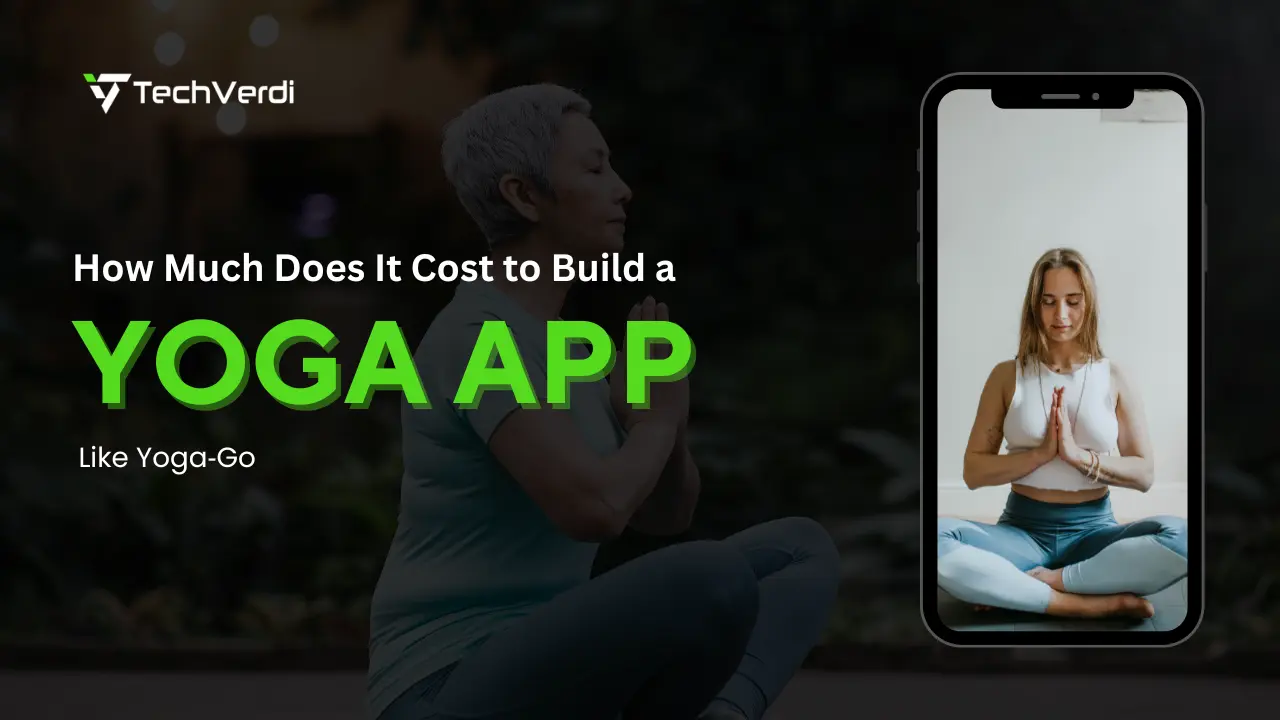
Have you ever thought, “What if I built a yoga app like Yoga-Go?” With 300 million global practitioners and the fitness app market worth over $10 billion, now is the perfect moment. This comprehensive guide breaks down how much it costs to build a yoga-go style app, what influences pricing, and practical strategies for managing your budget all explained clearly for non-tech founders.
What Is Yoga‑Go & Why It’s So Popular?
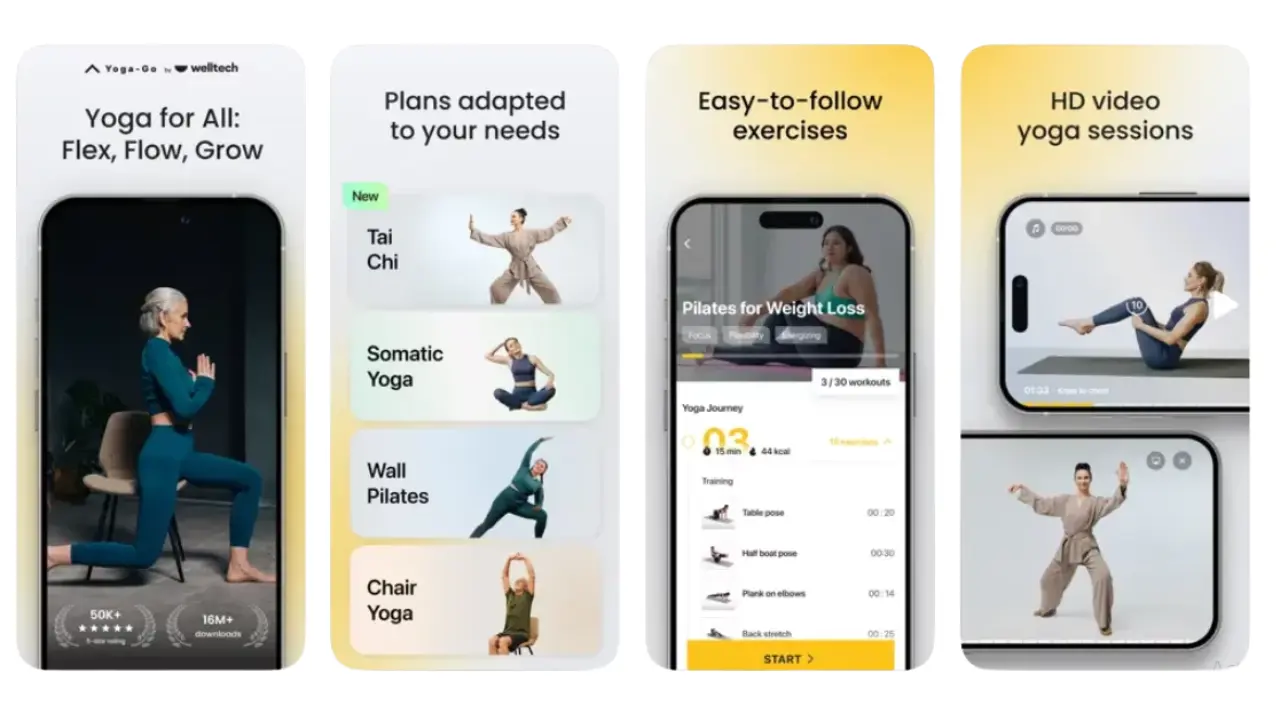
Yoga‑Go is a digital wellness app that offers personalized yoga and Pilates plans tailored for users at every level, from beginners to advanced practitioners. Its popularity stems from key features that enhance user experience such as customized routines based on age, fitness goals, and experience level; progress tracking through workout logs and visual milestones; and flexible session lengths ranging from quick 7-minute flows to longer 30+ minute workouts.
The app also provides offline access for uninterrupted practice, nutrition plans with healthy recipes for a holistic wellness approach, and seamless integration with wearables like Apple Health, Google Fit, and Fitbit. This user-first design focusing on convenience, personalization, and engagement is exactly why Yoga‑Go remains a top choice and why searches like “cost to build yoga app” continue to rise in 2025.
Looking to develop an innovative mobile app for your business?
How Much Do Users Pay for Yoga‑Go in 2025?
Here’s the latest subscription pricing:
|
Plan |
Price |
|---|---|
|
7-Day Free Trial |
Free |
|
Monthly Premium |
$19.99/month |
|
Quarterly Subscription |
$34.99/quarter |
|
Annual Premium Subscription |
$52.99/year |
|
One-time Weight-Loss Guide |
$29.99 |
|
Monthly Weight-Loss Add-On |
$9.99/month |
Understanding user willingness to pay helps position your yoga app’s pricing strategy effectively.
Want to Create Cash Advance App?
What Type of Yoga App Should You Build in 2025? (With Cost Estimates)
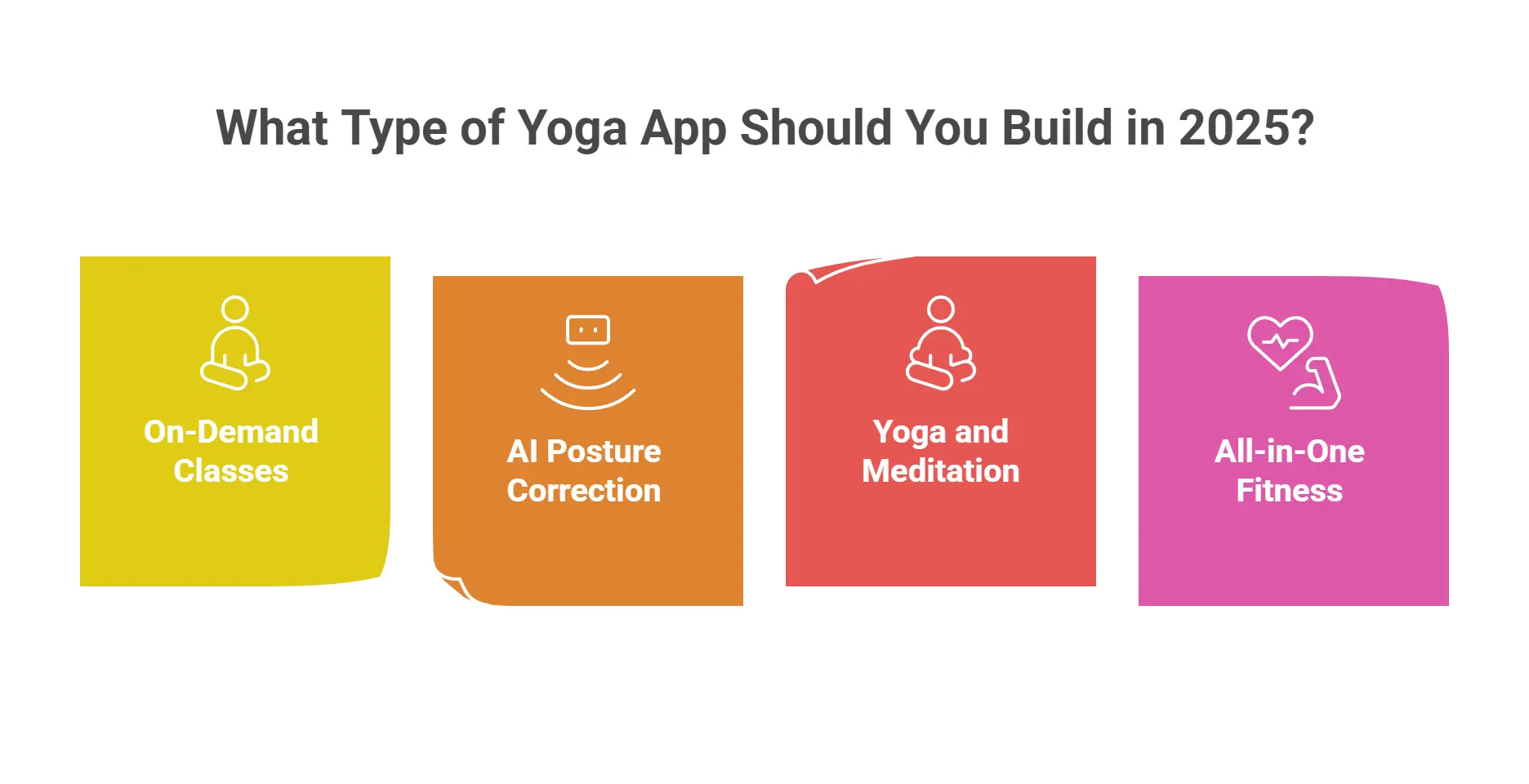
Before diving into development, it’s important to understand what type of yoga app you want to create. Not all yoga apps are built the same and depending on your business goals, audience, and budget, the kind of app you choose will determine your feature set, development complexity, and total cost.
Let’s walk through the top 4 yoga app types in 2025 and explore what each offers along with their estimated development costs.
1. On-Demand Yoga Class Apps ($50,000 – $120,000)
This is the most common yoga app type in today’s market. These apps offer pre-recorded yoga sessions that users can access anytime, anywhere. Think of platforms like Yoga International, Glo, or Alo Moves.
They typically include:
- A categorized library of yoga videos (by style, level, duration).
- Instructor profiles.
- Subscription-based access.
- Bookmarking, favorites, and progress tracking.
These apps are great for beginners and casual users looking for flexibility. If you’re launching a wellness brand or yoga studio online, this model is cost-effective and user-friendly. Expect a development cost ranging from $50,000 to $120,000, depending on video quality, cloud infrastructure, and app platform (iOS, Android, or both).
2. AI-Based Posture Correction Apps ($80,000 – $150,000+)
Apps in this category use AI and computer vision to analyze your yoga poses in real time, correcting form and guiding users like a personal trainer would. Yoga-Go, Asana Rebel, and similar platforms have popularized this model.
Key features typically include:
- Real-time camera-based posture analysis.
- AI-powered feedback and recommendations.
- Integration with smart wearables or motion sensors.
- Personalized daily yoga flows.
These apps appeal to fitness enthusiasts, seniors, and people who need corrective guidance. While powerful, AI yoga apps are technically complex and more expensive starting around $80,000, and going beyond $150,000 depending on your tech stack and AI training requirements.
3. Yoga + Meditation Combo Apps ($40,000 – $100,000)
Not everyone wants a sweat-dripping workout. Many users seek mental wellness, stress relief, and sleep support. That’s where yoga and mindfulness apps come in. Popular apps like Calm and Headspace combine yoga, breathwork, and meditation to create a calming experience.
These apps generally offer:
- Guided meditation sessions.
- Breathing exercises.
- Gentle yoga/stretch routines.
- Sleep sounds and relaxation music.
If you’re targeting users searching for “yoga for stress,” “yoga sonora,” or “yoga go cost for seniors,” this model offers high value and low-intensity workouts. These apps are also cheaper to build, with average development costs between $40,000 and $100,000.
4. All-in-One Fitness & Wellness Apps ($60,000 – $130,000)
Looking to compete with big fitness apps like FitOn, Daily Yoga, or MyFitnessPal? Then you’ll want to build a hybrid yoga-fitness app. These platforms include yoga, pilates, HIIT workouts, meal plans, health tracking, and even community forums.
A full-featured wellness app might include:
- Yoga, fitness, and nutrition plans.
- Wearable integration (like Fitbit or Apple Watch).
- Progress analytics and fitness goals.
- In-app community or forum features.
- Recipe libraries and health articles.
These apps are ideal for long-term user engagement and monetization, with subscription tiers, upselling, and push notifications. Development costs vary widely but generally fall between $60,000 and $130,000, depending on scale and integrations.
Connect With TechVedi Today to Get Your Software Integrated and Synchronized.
What Impacts the Cost of Yoga App Development in 2025?
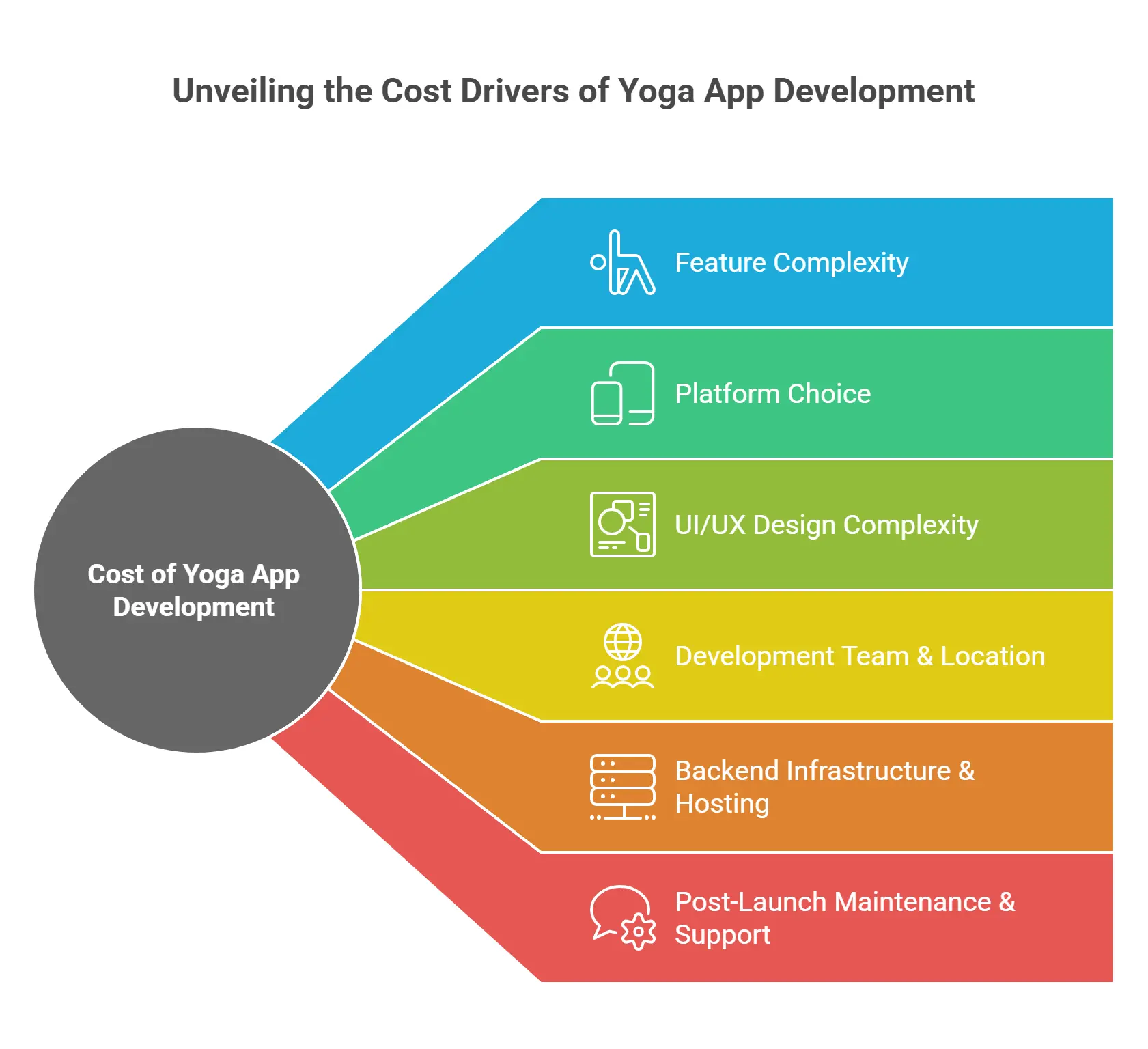
If you’re wondering why some yoga apps cost $20,000 while others stretch past $150,000, it’s all about the cost-driving factors behind the scenes. Every feature, design choice, and development strategy plays a role in how much you’ll need to invest.
Let’s break down the 6 most important factors that affect yoga app development costs in 2025:
1. Feature Complexity
The biggest price tag difference comes down to what your app can do. A basic app with login, video playback, and a calendar costs far less than one that uses AI to correct posture in real-time. Want social sharing, push notifications, or gamified achievements? These enhancements add to development hours and infrastructure.
Example: A simple app that plays pre-recorded yoga sessions might cost $30K, but adding real-time pose detection with AI can push it past $100K.
2. Platform Choice: iOS, Android, or Both
Are you building for iPhone, Android, or both? Native apps (built specifically for iOS or Android) offer smoother performance but cost more. If you’re looking to save money and reach more users, cross-platform development (using Flutter or React Native) lets you build once and deploy to both platforms reducing cost by up to 40%.
Tip: Cross-platform is perfect for startups and MVPs. Go native if you want top performance and deep device integration.
3. UI/UX Design Complexity
Your design directly impacts how users feel about your app. A clean, intuitive layout is the baseline, but if you want your app to stand out, you’ll need animations, branded themes, personalized dashboards, and smooth navigation flows. These take time and budget to craft.
|
Region |
Hourly Rate (USD) |
|---|---|
|
North America |
$100 – $200/hr |
|
Western Europe |
$80 – $150/hr |
|
Eastern Europe |
$40 – $80/hr |
|
South Asia |
$20 – $50/hr |
Pro tip: Outsourcing to a reputable offshore partner can reduce development costs by up to 60%, without sacrificing quality.
5. Backend Infrastructure & Hosting
Every yoga app needs a strong backend especially if you’re streaming videos, managing user data, or integrating third-party services (like wearables or payment systems). Using cloud platforms like AWS, Firebase, or Azure ensures scalability and performance, but these come with monthly hosting and storage fees.
|
Infrastructure Type |
Annual Cost Estimate |
|---|---|
|
Basic Cloud Hosting |
$5,000 – $15,000 |
|
Advanced Streaming & AI Backends |
$20,000 – $50,000 |
Choose scalable backend solutions early to avoid rebuilding when your app starts gaining traction.
6. Post-Launch Maintenance & Support
Building the app is just step one. Once it’s live, you’ll need ongoing maintenance bug fixes, OS updates, performance monitoring, and new features. Budget at least 15–20% of your initial app cost annually for smooth operation and user satisfaction.
Example: If your app costs $80,000 to build, reserve at least $12,000–$16,000/year for reliable maintenance and updates.
Ensure data security and compliance with custom CRM solutions
Estimated Budget Ranges by App Type (2025 Edition)
Understanding your budget before diving into development is key. Whether you’re launching a basic yoga companion app or an AI-powered wellness platform, having a clear idea of what each app tier costs in 2025 will help you plan better and avoid budget surprises later.
Here’s a breakdown of the typical development costs based on the type of yoga or wellness app you want to build:
|
App Type |
Who It's For |
Key Features |
Estimated Cost (USD) |
|---|---|---|---|
|
MVP – Basic Yoga App |
Startups or solo founders |
Pre-recorded sessions, user registration, basic tracking |
$20,000 – $40,000 |
|
Mid-Tier Yoga App |
Growing businesses or fitness influencers |
Personalized routines, in-app purchases, limited AI features |
$50,000 – $80,000 |
|
AI-Enhanced Yoga App |
Companies targeting smart wellness solutions |
Real-time pose correction, AI chat support, wearable integrations |
$100,000 – $150,000+ |
|
Enterprise Wellness App |
Corporates or funded health startups |
Team management, multi-user profiles, integrations with HR systems |
$150,000 – $250,000+ |
|
All-in-One Wellness Platform |
Broad health brands or fitness tech startups |
Yoga + fitness, diet plans, live classes, community features |
$60,000 – $130,000 |
What These Cost Ranges Include
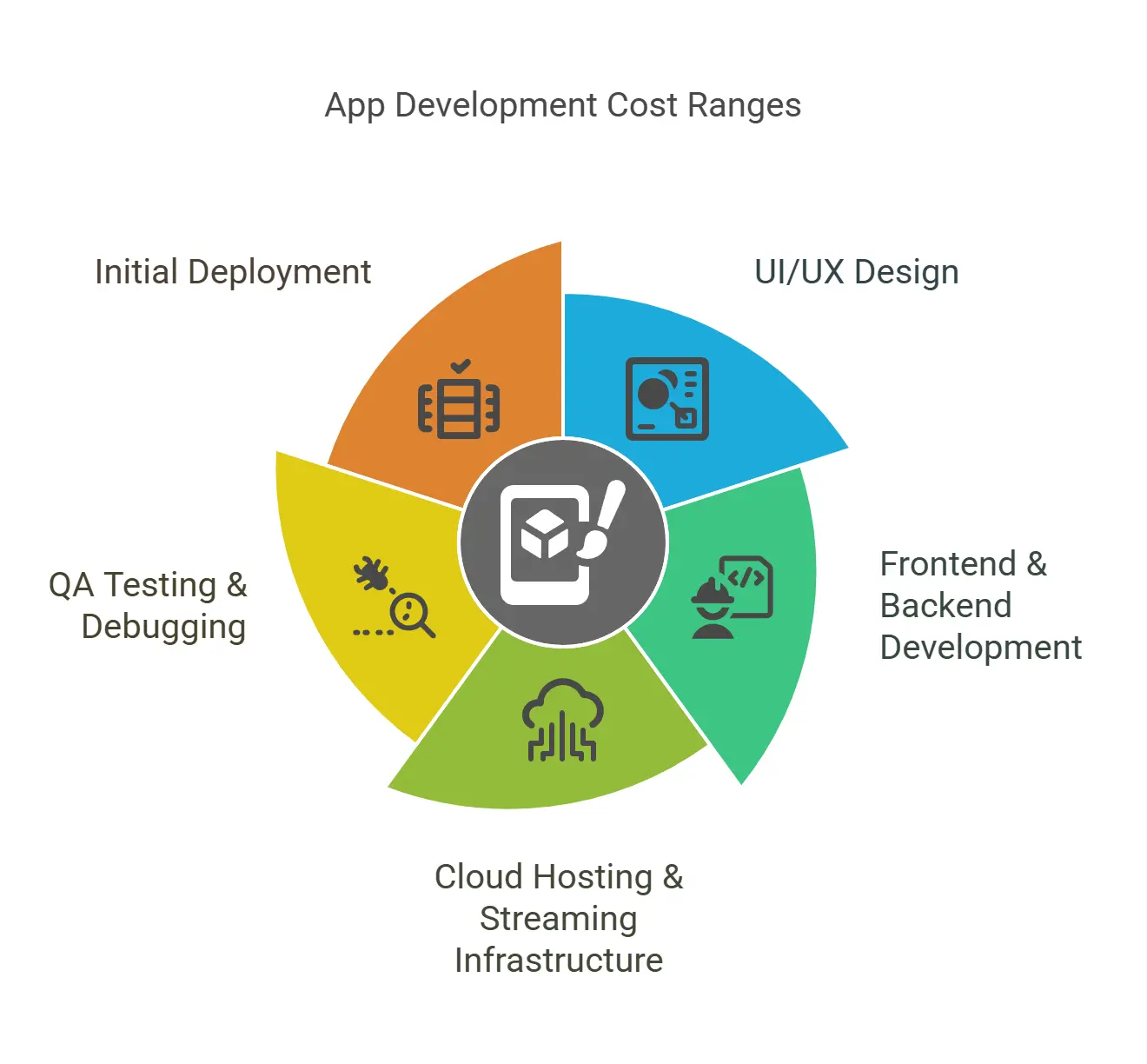
These budgets typically include everything needed to go from idea to app store launch:
- UI/UX Design: Branding, user flows, responsive layouts.
- Frontend & Backend Development: Mobile app code, database setup, API integrations.
- Cloud Hosting & Streaming Infrastructure: Platforms like Firebase, AWS, or Azure.
- QA Testing & Debugging: Ensuring smooth user experience on iOS and Android.
- Initial Deployment: Play Store & App Store submissions.
Unlock Growth with TechVerdi’s Solutions
Feature-by-Feature Cost Breakdown (Updated for 2025)
|
Feature |
What It Does |
Why It Matters |
Estimated Cost (USD) |
|---|---|---|---|
|
User Authentication & Profiles |
Enables users to register, log in, and manage personal details |
Personalization, security, and data syncing across devices |
$3,000 – $6,000 |
|
Workout Library with Filters |
Organized collection of video/audio sessions with advanced filters |
Provides variety, enhances usability, and user retention |
$6,000 – $18,000 |
|
Progress Tracker & Analytics |
Tracks user goals, completed sessions, calories burned, etc. |
Encourages consistency and builds engagement over time |
$6,000 – $14,000 |
|
AI-Based Posture Correction |
Uses computer vision or sensors to correct yoga poses in real time |
Delivers smart, real-time feedback mimicking a personal trainer |
$20,000 – $40,000 |
|
Wearable Device Integration |
Connects app to Apple Watch, Fitbit, or Google Fit for real-time data |
Enables deeper health insights and increases daily engagement |
$6,000 – $12,000 |
|
Offline Access Mode |
Allows users to download classes and use the app without internet |
Improves accessibility for travelers or users in remote areas |
$4,000 – $8,000 |
|
Meal Plans & Nutrition Library |
Offers curated meal suggestions, grocery lists, and diet tips |
Supports holistic wellness and increases app’s premium value |
$6,000 – $16,000 |
|
Live Streaming Classes |
Real-time virtual yoga sessions with interactive capabilities |
Great for monetization, personalization, and community building |
$18,000 – $35,000 |
Smart Ways to Reduce Your Yoga App Development Cost in 2025
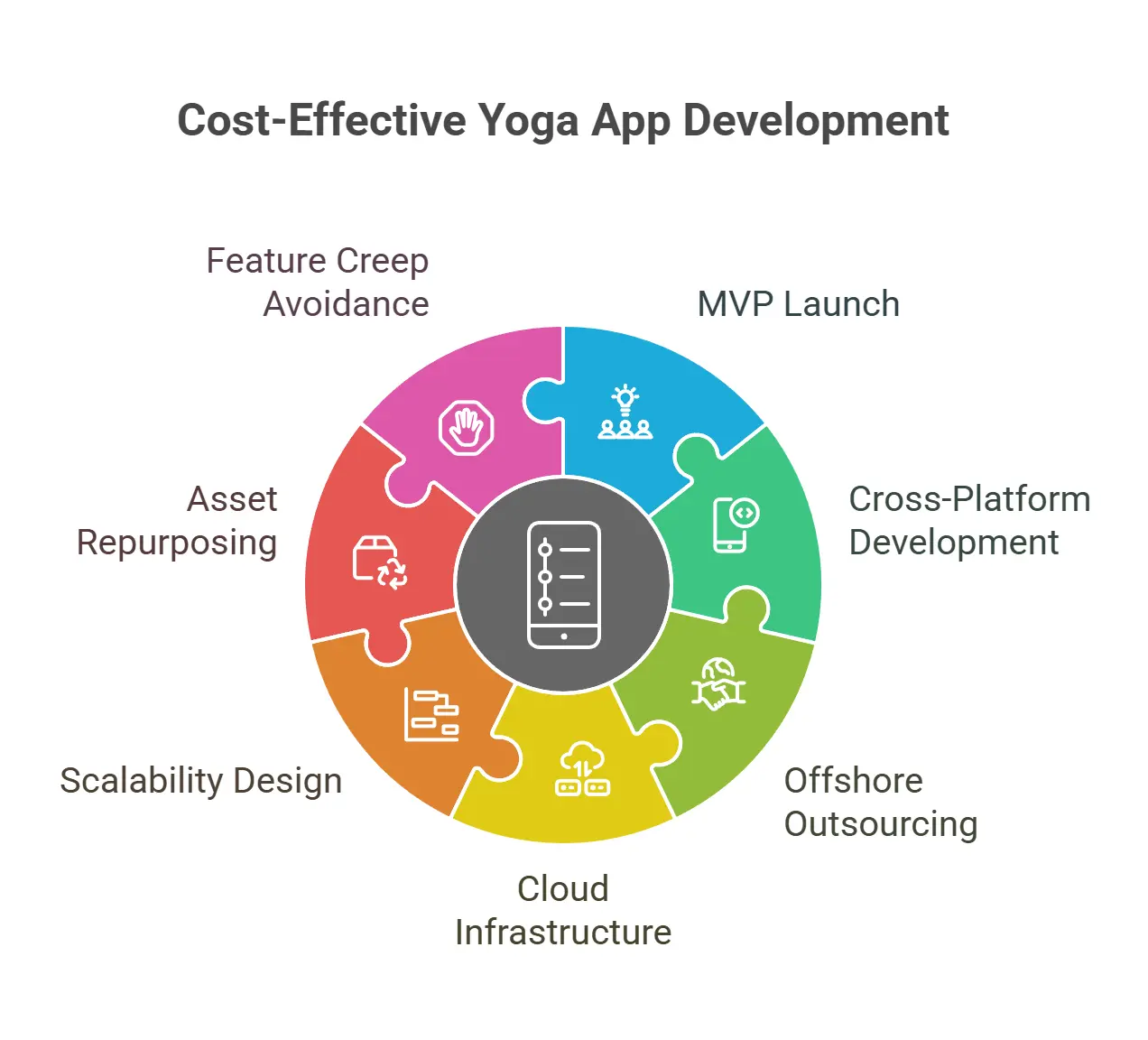
Building a yoga app like Yoga-Go doesn’t have to drain your budget. With the right strategy and smart decisions, you can reduce development costs significantly without compromising on quality. Here are seven effective ways to keep your app project lean and scalable in 2025:
1. Launch a Minimum Viable Product (MVP) First
Instead of building every feature from day one, start with a simplified version of your app that includes only the core features like video classes, user login, and progress tracking.
- Why it works: You’ll test your idea quickly, validate user interest, and invest further only when traction begins.
- Example: Launch with 10 pre-recorded yoga sessions, a basic tracker, and payment gateway then add AI or wearable integrations later.
2. Choose Cross-Platform Development (Flutter/React Native)
Using cross-platform frameworks allows you to develop for both iOS and Android simultaneously, cutting your time-to-market and dev cost by 30-40%.
- Why it works: It saves on developer hours and ensures a consistent UI/UX across devices.
- Bonus: Flutter now supports seamless animations and native performance, perfect for wellness apps.
3. Outsource to Reliable Offshore Teams
Hiring development teams in countries like Ukraine, or the Philippines can save up to 60% on development expenses without sacrificing quality if you choose the right partner.
- What to look for: Portfolio of similar fitness/wellness apps, transparent communication, and agile process.
4. Leverage Cloud or Serverless Infrastructure
Instead of building and maintaining traditional servers, use cloud services like AWS Lambda, Firebase, or Azure Functions.
- Why it works: Serverless backends reduce infrastructure costs, offer automatic scaling, and handle peak loads (e.g., during live yoga sessions).
5. Design for Scalability from Day One
Modular architecture and API-driven development allow you to add features later without major rework.
- For example: If you plan to add AI posture detection later, design your architecture to support it with APIs or plug-ins.
6. Repurpose Existing Assets and UI Kits
Don’t reinvent the wheel. Use pre-built UI templates, open-source libraries, and ready-made components (like calendar plugins or workout schedulers).
- Why it works: Reduces design and dev time while maintaining quality and aesthetics.
- Bonus tip: Platforms like Figma and Envato offer yoga/fitness-specific UI kits.
7. Avoid Feature Creep
It’s tempting to add every cool feature but each one adds dev time, complexity, and maintenance cost.
- Stick to this rule: Only build features that directly improve user outcomes or revenue potential.
- Tip: Track usage metrics post-launch to decide what features to build next based on user demand.
Ready to Build an AI Chatbot That Performs?
Whether you’re looking to build an interactive character like Janitor AI, a revenue-producing chatbot, or an enterprise-grade reliable solution — TechVerdi is your partner to build, own, and scale it right.
Is investing in a Yoga app worth it in 2025?
2025 is a golden opportunity for yoga app founders.
- The global fitness app market hit $10.6 billion in 2024 and is growing at 13.9% CAGR, fueled by health-conscious lifestyles.
- Users crave personalized workouts, AI-guided sessions, and community-driven features, making niche apps like yoga highly attractive.
- With recurring subscription models, in-app purchases, and premium content, yoga apps offer a strong path to scalable revenue.
- A well-built app boosts user engagement, retention, and brand loyalty making it more than a trend; it’s a smart digital investment.
Next Steps: From Idea to Launch
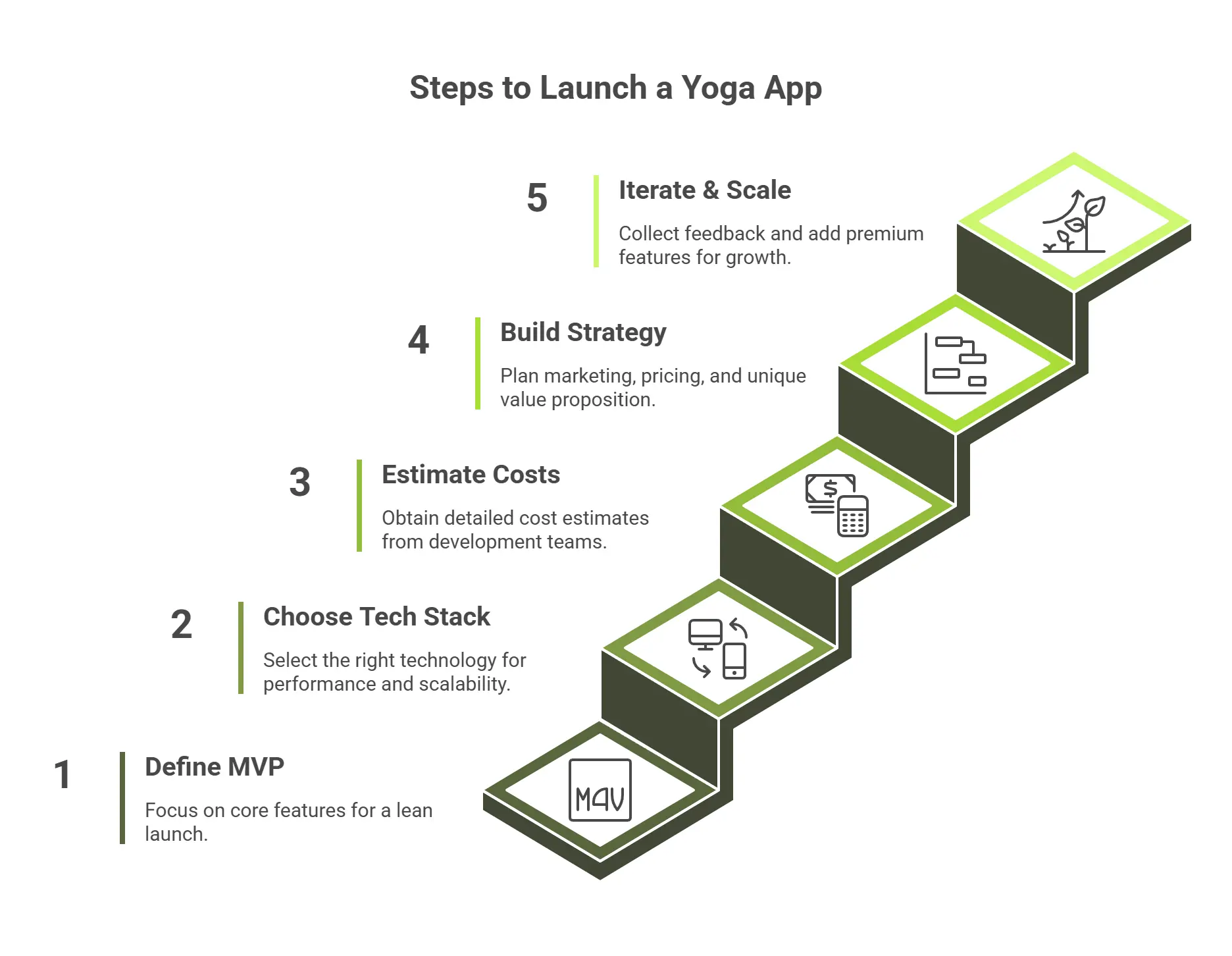
You’ve got the vision now, it’s time to bring your yoga app to life. Follow these proven steps to go from concept to a successful app launch in 2025:
Define Your MVP (Minimum Viable Product):
Focus on core features like user profiles, workout videos, and basic tracking. Launch lean, learn fast.
Choose the Right Tech Stack:
Decide between native development (for top-tier performance) or cross-platform (for budget-friendly scalability). Don’t forget reliable cloud hosting (AWS, Firebase, etc.).
Get Detailed Cost Estimates:
Approach trusted mobile app development teams with a clearly defined scope. Request quotes, timelines, and portfolios to compare.
Build Your Launch & Monetization Strategy:
Plan how you’ll market the app, price subscription plans, offer trials, and promote your unique value in a crowded market.
Iterate and Scale:
Post-launch, collect user feedback and continuously enhance your app. Add premium features like AI posture correction, wearable integration, or community tools.
Conclusion
Creating a Yoga-Go style app in 2025 is more than just a trend, it’s a powerful business opportunity. With the global fitness app market booming and consumers seeking accessible, personalized wellness solutions, now is the perfect time to invest in yoga app development.
By leveraging a clear development strategy, prioritizing user experience, and integrating high-impact features like AI-driven coaching, wearable connectivity, and personalized routines, you can build an app that stands out in a competitive market and generates long-term value.
Whether you’re starting with a basic MVP or planning a feature-rich app with AI capabilities and holistic wellness, your success depends on a well-defined roadmap and the right development partner.
FAQs
The average cost to build a yoga app like Yoga-Go in 2025 ranges from $25,000 to $150,000, depending on features, platform, and developer location.
Yoga-Go offers a free trial but requires a subscription for full access. Plans range from $14.99/month to $52.99/year, with optional add-ons.
Key features include personalized plans, on-demand videos, progress tracking, offline mode, AI-based posture correction, and nutrition guidance.
It typically takes 3 to 6 months to build a basic yoga app, while complex apps with AI features or cross-platform support may take 6 to 12+ months.
Main cost factors include feature complexity, platform choice (iOS/Android/Cross-platform), UI/UX design, development team location, and maintenance.
Yes, you can reduce costs by starting with an MVP (Minimum Viable Product), using cross-platform development, or outsourcing to cost-efficient regions.
Cross-platform apps (built with Flutter or React Native) are ideal for reaching both Android and iOS users while saving up to 40% in development costs.
Yes, AI can be integrated to offer features like real-time posture correction, personalized workout suggestions, and automated coaching.
Annual maintenance costs for a yoga app range between $5,000 and $50,000, based on update frequency, bug fixes, and server usage.
Yes, with the fitness app market projected to reach $23B+ by 2030, yoga apps offer high demand, subscription revenue, and strong ROI potential.
